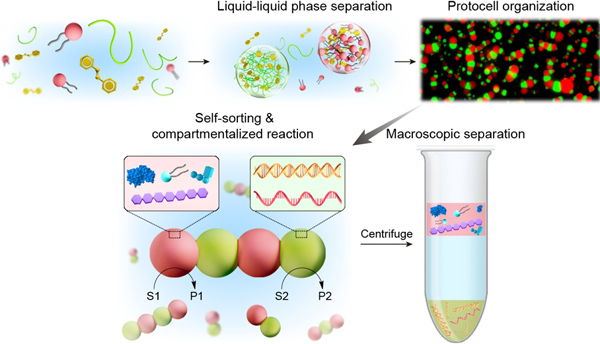Researchers Develop Self-sorting Coacervates for High-order Protocell Networks
Protocell networks assembled by artificial cell-like compartments have been developed for the expansion of cell-mimicking functionalities, such as signal processing, protein expression, morphological differentiation, and energy harvesting.
In a study published in Nature Chemistry, a research team led by Prof. Yan Qiao at the Institute of Chemistry of the Chinese Academy of Sciences, Prof. Stephen Mann at University of Bristol, and Prof. Yiyang Lin at Beijing University of Chemical Technology, report a binary population of immiscible coacervate microdroplets that spontaneously self-sort into interconnected protocell networks. The self-assembled protocell superstructure is thermodynamically organized in the form of linear and branched chains with an alternating sequence of liquid crystalline coacervates and non-structured microdroplets, in which the two immiscible droplets adhere to each other. The networks are self-sorted constructs driven by the surface energy minimization of coacervate droplets in a restraining force-field generated by the local surface adhesion interactions.
These two populations of coacervates exhibit distinct internal structures and order, where the liquid crystalline droplets are conducive to the selective uptake of proteins, polysaccharides, lipids, and ATP. In contrast, non-structured coacervates formed by positively charged polyelectrolytes and small molecules are capable of enriching nucleic acids. This property enables the protocell networks to spatially localize biochemical reactions in separate compartments. For example, horseradish peroxidase-mediated oxidation of Amplex red is confined in the liquid crystalline domain and hammerhead ribozyme-induced cleavage of FRET-substrate strand is localised in homogeneous microdroplets. Additionally, the pre-loaded oligonucleotide in liquid crystalline coacervates is transferred into an adjacent homogeneous domain since the solubility of oligonucleotide in the receiver droplets is energetically favoured. The authors further demonstrated that topographical reconfiguration of protocell network could be stimulated by host-guest complexation, photo-isomerization, and salt-induce dissolution. Moreover, the authors utilized the protocell networks to isolate oligonucleotides from mixtures containing proteins, polysaccharides, lipids, or ATP. Finally, the protocell networks consisting of surface engineered coacervates are able to restrict self/self-droplet coalescence and assemble into tissue-like 2D superstructures.
Taken together, the coacervate-based protocell superstructures represent a step towards the spontaneous orchestration of artificial multicellular colonies with higher-order organization and collective functions.

Self-sorting coacervate-based protocell networks (Image by Prof. QIAO Yan)
Contact:
Prof. Yan Qiao
Institute of Chemistry, Chinese Academy of Sciences
Email: yanqiao@iccas.ac.cn





